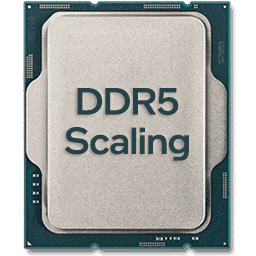DDR5 Memory Performance Scaling with Alder Lake Core i9-12900K
Source: Tech Power Up added 28th Nov 2021Introduction
Intel’s 12th Gen “Alder Lake” processors are a well-rounded new desktop processor lineup that impressed us in many ways with the quirky but powerful heterogenous multi-core technology and next-generation I/O, such as DDR5 memory and PCI-Express Gen 5. Intel gives you the flexibility of pairing these processors with either DDR5 or older DDR4 memory, and ensured there are plenty of motherboard options for both memory types. We explored just how much of a performance difference exists between the two in our previous article on DDR5 vs. DDR4 with the i9-12900K. The results fascinated us, and you should definitely check them out as they serve as a prelude to this article.
The new DDR5 memory comes with the expected early-adopter tax, and prices of memory modules range wildly mostly based on frequency. A single 16 GB DDR5-4800 module costs around $120, but overclocked modules, such as DDR5-5200 and DDR5-6000, or higher, could cost double or even triple that. Granted, these only cater to a niche crowd, but we’re curious to see just how much performance you “lose” by sticking to the DDR5-4800, which Intel considers baseline for the “Alder Lake” memory controllers.
Another question we had over the course of our testing was what if we went below DDR5-4800? How would such a thing compare to higher-frequency DDR4? Playing with memory settings is extremely easy on the Intel platform as “Alder Lake” allows on-the-fly memory overclocking from within Windows with Extreme Tuning Utility (XTU), so we obtained data for a number of DDR5 frequency and latency combinations, including a couple of low-frequency configurations to compare with DDR4. The DDR4-3600 configuration we’re using in our review runs in “Gear 1” mode for synchrony between the memory controller command frequency and DRAM clock, while DDR5 is implicitly Gear 2 across the board—a 1:2 divider between the command frequency and DRAM clock. In this article, we investigate how performance of the Core i9-12900K scales across a selection of DDR5 frequencies, with a popular DDR4 frequency added for good measure.
Test Setup
| Test System | |
|---|---|
| Processor: | Intel Core i9-12900K 8+8 Cores / 24 Threads 3.9 GHz Base, 5.2 GHz Boost Intel default power limits (PL1=PL2=241 W) |
| Motherboard: | ASUS Z690 Maximus Hero / BIOS 0702 |
| Memory: | 2x 16 GB G.SKILL Trident Z5 RGB DDR5-6000 36-36-36-76 2T / Gear 2 DDR5-5600 36-36-36-76 2T / Gear 2 DDR5-5200 36-36-36-76 2T / Gear 2 DDR5-4800 36-36-36-76 2T / Gear 2 DDR5-4400 36-36-36-76 2T / Gear 2 DDR5-4000 36-36-36-76 2T / Gear 2 DDR5-3600 36-36-36-76 2T / Gear 2 DDR5-3200 36-36-36-76 2T / Gear 2 DDR5-2800 36-36-36-76 2T / Gear 2 DDR5-2400 36-36-36-76 2T / Gear 2 DDR5-4800 30-30-30-70 2T / Gear 2 2x 16 GB G.SKILL Ripjaws V |
| Graphics: | EVGA GeForce RTX 3080 FTW3 Ultra |
| Storage: | Neo Forza NFP065 1 TB M.2 NVMe SSD |
| Air Cooling: | Noctua NH-U14S |
| Water Cooling: | Arctic Liquid Freezer II 360 mm |
| Thermal Paste: | Arctic MX-5 |
| Power Supply: | Seasonic SS-860XP |
| Software: | Windows 10 Professional 64-bit / 21H1 Windows 11 Professional 64-bit / 10.0.22000.282 |
| Drivers: | NVIDIA GeForce 496.49 WHQL |
Other test systems are the same as in our Core i9-12900K review.
media: Tech Power Up
Related posts
Notice: Undefined variable: all_related in /var/www/vhosts/rondea.com/httpdocs/wp-content/themes/rondea-2-0/single-article.php on line 88
Notice: Undefined variable: all_related in /var/www/vhosts/rondea.com/httpdocs/wp-content/themes/rondea-2-0/single-article.php on line 88
Related Products
Notice: Undefined variable: all_related in /var/www/vhosts/rondea.com/httpdocs/wp-content/themes/rondea-2-0/single-article.php on line 91
Warning: Invalid argument supplied for foreach() in /var/www/vhosts/rondea.com/httpdocs/wp-content/themes/rondea-2-0/single-article.php on line 91
